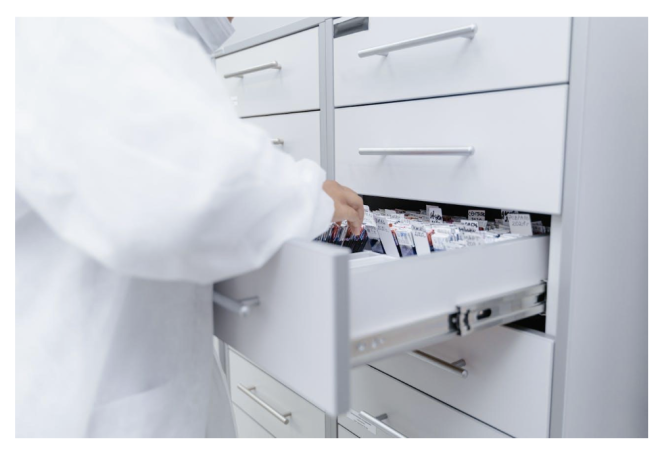- Change theme
Setting Up a Medicine Cabinet in a Care Home or Clinic

Storing medication in a care home or clinical setting must be safe, compliant, and closely monitored.
00:32 30 July 2025
Storing medication in a care home or clinical setting must be safe, compliant, and closely monitored. A medicine cabinet is the foundation, but if you're handling temperature-sensitive treatments, you also need a reliable way to track storage conditions.
Why the Right Medicine Cabinet Setup Matters
Professional medicine storage needs to follow strict guidelines, protecting patient safety and ensure that medications are effective when they’re needed most.
Most facilities use metal, wall-mounted cabinets with restricted access. Inside, medicines are usually separated by type: routine daily prescriptions, controlled drugs, and PRN (as-needed) medications. This reduces the risk of dosing errors and avoids unnecessary delays during medication rounds.
You’ll also need to keep everything clearly labelled, especially if multiple patients’ medicines are stored in the same cabinet. The Care Quality Commission (CQC) offers detailed guidance on layout and access controls. Cabinets should be installed away from heat sources or humidity to prevent deterioration of the drugs inside.
The Importance of Temperature Control
Some medicines are stable at room temperature, but many are not. If you’re storing insulin, vaccines, eye drops, or certain antibiotic suspensions, the environment matters.
Certain medicines have strict temperature ranges, usually between 2°C and 8°C, and even short-term deviations can make them less effective. Once compromised, a medicine might look normal but fail to work as intended. This is particularly concerning in care homes, where patients may already have complex health needs.
A domestic fridge is not good enough for professional medicine storage. Household fridges can fluctuate in temperature, especially if they’re frequently opened. And ambient room conditions may vary throughout the day, depending on where your cabinet is located.
What a Data Logger Does
A data logger is a small digital device that records temperature readings over time. It builds a picture of the storage environment across hours or days. You can identify patterns, detect problems early, and provide evidence that your medicine storage is compliant.
Some data loggers offer USB download, while others connect to cloud-based systems to give you a full report for audit purposes. You can set alert thresholds so that you’re notified if the temperature rises too high or falls too low. This is useful for weekend monitoring or out-of-hours checks.
By placing a data logger inside your medicine cabinet or refrigerator, you’ll be able to:
- Track real-time and historical temperatures
- Identify spikes caused by power cuts or equipment faults
- Print or store temperature logs for inspections
- Avoid having to discard medicine unnecessarily due to unverified temperature excursions
How to Combine Storage and Monitoring
First, choose a purpose-built medicine cabinet with strong, tamper-resistant features. Install it in a well-ventilated area, ideally away from windows or heating units.
For cold-chain medicines, use a dedicated medical fridge. Then place your data logger directly inside the cabinet or fridge, ideally at the centre shelf, to avoid skewed readings caused by hot or cold spots. If your logger supports automatic uploads, consider integrating it into your digital records to reduce manual tasks.
Even if your system logs data automatically, someone should still review it regularly and record any action taken when temperatures fall outside the safe range.
Training Staff and Keeping It Consistent
All staff who handle medicines should be trained not only on cabinet access and medication handling, but also on how to use and interpret the data logger. They should know where the logger is located, how to read temperature logs, what to do if temperatures are out of range, and who to report to.
You may already have protocols in place, but this is an area that benefits from regular refreshers. Procedures around fridge cleaning, restocking, or power failures should all include reference to temperature monitoring. It also helps to assign responsibility clearly.
Supporting Compliance and Inspection Readiness
A medicine cabinet alone doesn’t prove that medicines were stored correctly, but a data logger does. If you’re preparing for a CQC visit or internal audit, you’ll be asked about how you monitor conditions. Having a clear record of temperature logs, with dates, times, and any interventions, can be the difference between an acceptable rating and a follow-up inspection.
It also protects you if there’s ever a question about the efficacy of a medication that was administered. Instead of relying on memory or ad hoc fridge checks, you’ll have clear, timestamped data.
Final Thoughts
You need to know that the environment inside that cabinet or fridge is suitable, especially for temperature-sensitive treatments. A data logger helps you do that consistently, accurately, and in a way that’s easy to evidence when it counts.
Combine a professional medicine cabinet with reliable temperature monitoring and you’re helping stay compliant and making sure that every dose has the best chance of doing its job.
